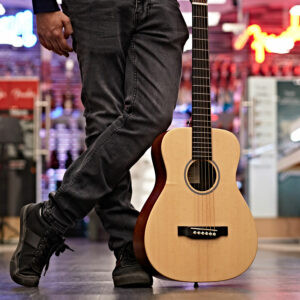Choosing the right guitar size is a crucial first step, especially for beginners. Among the various options, the 3/4 size guitar stands out as a popular choice. But what exactly is the Size Of A 3/4 Guitar, and why might it be the perfect fit for some players? Let’s delve into the dimensions, benefits, and who would most benefit from this versatile instrument.
Unpacking the Dimensions of a 3/4 Guitar
 Martin LX1L Little Martin Left-Handed Guitar
Martin LX1L Little Martin Left-Handed Guitar
The size of a 3/4 guitar is characterized by its more compact form factor compared to a standard full-size guitar. Typically, a 3/4 guitar measures around 36 inches in total length and 13 inches in width at its widest point. Crucially, the scale length, which is the vibrating length of the strings and a key factor in playability, ranges from approximately 20 to 24 inches. This shorter scale length is complemented by a narrower nut width and frets that are closer together.
These reduced dimensions significantly impact how the guitar feels and plays. The compact design minimizes physical strain, particularly on the fretting hand. Reaching across frets to form chords becomes less of a stretch, making it a much more accessible instrument, especially when learning those initial, sometimes challenging, chord shapes. For beginners or guitarists with smaller hands, the size of a 3/4 guitar offers a comfortable and encouraging introduction to playing.
Sound and Tone of a 3/4 Guitar
While the size of a 3/4 guitar naturally affects its sound, it’s important to understand what to expect tonally. It’s true that a 3/4 guitar won’t produce the deep, resonant bass and overall volume of a full-size dreadnought. However, it possesses its own unique sonic character. Expect a tone that is often described as punchy in the midrange with a bright and clear high-end. The specific tonewoods used in construction will heavily influence the final sound, so paying attention to materials is key, regardless of the guitar’s size.
One practical consideration related to the size of a 3/4 guitar is its tuning stability. Due to the shorter scale length and potentially lighter construction, these guitars may sometimes be slightly more susceptible to going out of tune compared to larger models. Regular tuning is therefore advisable, particularly during practice sessions.
The Feel and Playability Factor
The feel of a guitar is paramount, especially for developing players. The size of a 3/4 guitar contributes significantly to a comfortable playing experience. The reduced string tension, a direct result of the shorter scale length, makes pressing down strings and fretting notes less demanding on the fingers. This is a major advantage for beginners who are still building finger strength and calluses. Combined with its lightweight nature and smaller fret spacing, a 3/4 guitar is exceptionally comfortable for individuals with smaller hands or anyone seeking a portable and easy-to-handle instrument. However, players with significantly larger hands might find the fretboard somewhat cramped.
Who is a 3/4 Guitar Best Suited For?
The manageable size of a 3/4 guitar makes it an outstanding choice for several groups of players:
- Children and Young Learners: Its smaller dimensions are perfectly proportioned for children who are just starting their musical journey. The reduced reach and lighter weight make learning much less physically challenging and more enjoyable.
- Beginners of All Ages: Adult beginners can also greatly benefit from the easier playability of a 3/4 guitar. It can accelerate the learning process and reduce frustration in the initial stages.
- Travelers and Musicians on the Go: The portability of a 3/4 guitar is a major asset. Its compact size makes it ideal for travel, fitting easily into overhead compartments or car trunks. It’s a perfect companion for songwriting trips or practicing on the road.
- Players with Smaller Hands: Anyone with smaller hands, regardless of age or experience level, will find the reduced scale and narrower neck of a 3/4 guitar more comfortable and easier to navigate.
- Transition to Bass Guitar: Interestingly, 3/4 size bass guitars serve as an excellent stepping stone for guitarists looking to transition to bass. The scale length of a 3/4 bass is closer to that of a standard guitar, making the switch less daunting.
A Recommended 3/4 Guitar: The Taylor BT1 Baby Taylor
When considering a high-quality 3/4 guitar, the Taylor BT1 Baby Taylor Acoustic Guitar stands out. Despite its compact size, Taylor, renowned for their acoustic craftsmanship, has engineered this guitar to produce a surprisingly rich and vibrant tone. It features a solid Sitka spruce top, which is crucial for resonant sound, and boasts exceptional playability and robust construction. The BT1 is a popular choice for musicians seeking a premium 3/4 acoustic guitar that doesn’t compromise on sound quality.
In conclusion, understanding the size of a 3/4 guitar and its implications is key to determining if it’s the right instrument for you. Its compact dimensions, comfortable playability, and unique tonal characteristics make it a compelling option for beginners, travelers, and anyone seeking a smaller, more manageable guitar without sacrificing musicality.
